英语中比较need和dare
- 格式:docx
- 大小:13.35 KB
- 文档页数:1
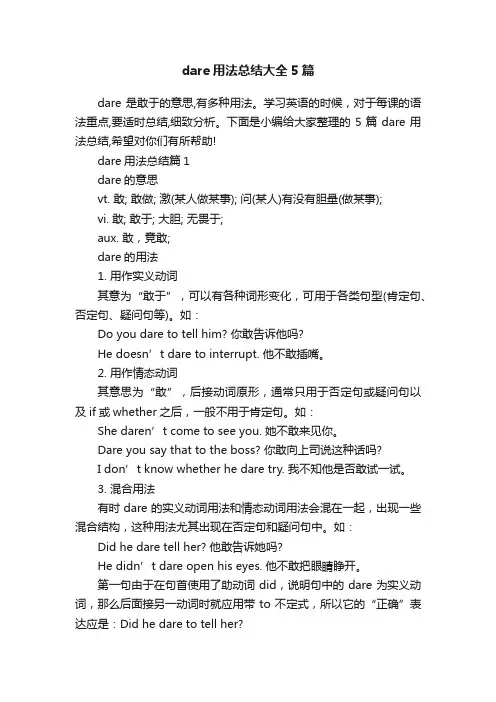
dare用法总结大全5篇dare是敢于的意思,有多种用法。
学习英语的时候,对于每课的语法重点,要适时总结,细致分析。
下面是小编给大家整理的5篇dare用法总结,希望对你们有所帮助!dare用法总结篇1dare的意思vt. 敢; 敢做; 激(某人做某事); 问(某人)有没有胆量(做某事);vi. 敢; 敢于; 大胆; 无畏于;aux. 敢,竟敢;dare的用法1. 用作实义动词其意为“敢于”,可以有各种词形变化,可用于各类句型(肯定句、否定句、疑问句等)。
如:Do you dare to tell him? 你敢告诉他吗?He doesn’t dare to interrupt. 他不敢插嘴。
2. 用作情态动词其意思为“敢”,后接动词原形,通常只用于否定句或疑问句以及if或whether之后,一般不用于肯定句。
如:She daren’t come to see you. 她不敢来见你。
Dare you say that to the boss? 你敢向上司说这种话吗?I don’t know whether he dare try. 我不知他是否敢试一试。
3. 混合用法有时dare的实义动词用法和情态动词用法会混在一起,出现一些混合结构,这种用法尤其出现在否定句和疑问句中。
如:Did he dare tell her? 他敢告诉她吗?He didn’t dare open his eyes. 他不敢把眼睛睁开。
第一句由于在句首使用了助动词did,说明句中的dare为实义动词,那么后面接另一动词时就应用带to不定式,所以它的“正确”表达应是:Did he dare to tell her?第二句由于在dare前使用了助动词didn’t,说明其中的dare为实义动词,所以当后接另一动词时应该用带to不定式,所以这一句的“正确”表达应是:He didn’t dare to open his eyes.这样的用法尽管我们阅读中可能会遇到,但最好不要模仿,因为如果考试中用它有可能会被判定为错误噢!4. I dare say前面我们讲过,dare用作情态动词通常不用于肯定句,但是I dare say是个例外,并且它已成为一个习惯说法,用于表示一种不肯定的语气,它的意思是“很可能”“大概”“我想”等。
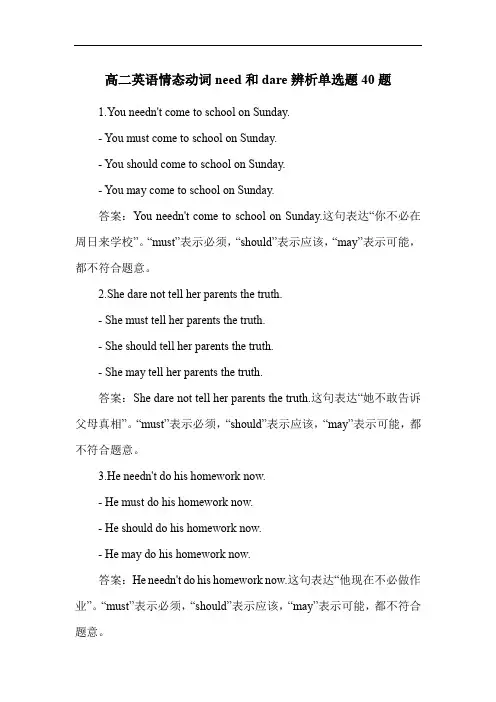
高二英语情态动词need和dare辨析单选题40题1.You needn't come to school on Sunday.- You must come to school on Sunday.- You should come to school on Sunday.- You may come to school on Sunday.答案:You needn't come to school on Sunday.这句表达“你不必在周日来学校”。
“must”表示必须,“should”表示应该,“may”表示可能,都不符合题意。
2.She dare not tell her parents the truth.- She must tell her parents the truth.- She should tell her parents the truth.- She may tell her parents the truth.答案:She dare not tell her parents the truth.这句表达“她不敢告诉父母真相”。
“must”表示必须,“should”表示应该,“may”表示可能,都不符合题意。
3.He needn't do his homework now.- He must do his homework now.- He should do his homework now.- He may do his homework now.答案:He needn't do his homework now.这句表达“他现在不必做作业”。
“must”表示必须,“should”表示应该,“may”表示可能,都不符合题意。
4.They dare not play basketball in the classroom.- They must play basketball in the classroom.- They should play basketball in the classroom.- They may play basketball in the classroom.答案:They dare not play basketball in the classroom.这句表达“他们不敢在教室里打篮球”。
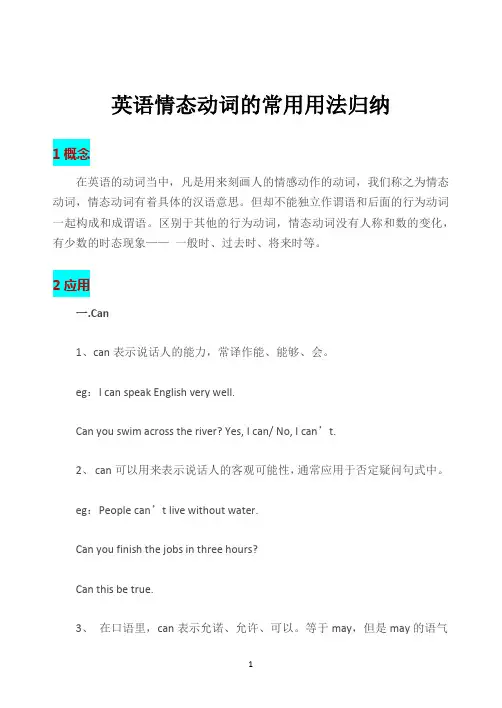
英语情态动词的常用用法归纳1概念在英语的动词当中,凡是用来刻画人的情感动作的动词,我们称之为情态动词,情态动词有着具体的汉语意思。
但却不能独立作谓语和后面的行为动词一起构成和成谓语。
区别于其他的行为动词,情态动词没有人称和数的变化,有少数的时态现象——一般时、过去时、将来时等。
2应用一.Can1、can表示说话人的能力,常译作能、能够、会。
eg:I can speak English very well.Can you swim across the river? Yes, I can/ No, I can’t.2、can可以用来表示说话人的客观可能性,通常应用于否定疑问句式中。
eg:People can’t live without water.Can you finish the jobs in three hours?Can this be true.3、在口语里,can表示允诺、允许、可以。
等于may,但是may的语气重于can。
eg:Can I come in? = May I come in?Can I use your bike? = May I use your bike ?*表示允许可以may mightcould can4、在“过去时”的语境里,通常用could 表示它的过去式,用be able to 短语(was/were)而could通常用来在一般现在时的语境里表示委婉语气eg:Could(can)you show me the way to the supermarket?5、can表示猜测(1)对现在状态的一种猜测,只能用在否定疑问句中。
eg:Zhang can’t be ill really?This can’t be done by him.(2)对现在动作的猜测eg: The boy can’t be telling lies.Mary works so hard, now, she can’t be sleeping.(3)对过去动作的一种猜测eg:He can’t have gone to the bookshop yesterday.Mother couldn’t have said it.6、can(could)惯用法(1)can’t wait to do 迫不及待做…….eg: Children can’t wait to eat apples in the basket.(2)can’t help doing 情不自禁做某事。
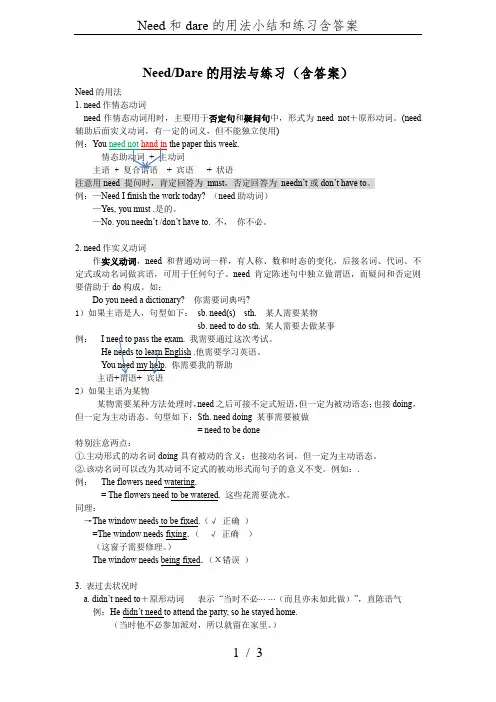
Need/Dare的用法与练习(含答案)Need的用法1. need作情态动词need作情态动词用时,主要用于否定句和疑问句中,形式为need not+原形动词。
(need 辅助后面实义动词,有一定的词义,但不能独立使用)例:宾语+ 状语注意用need 提问时,肯定回答为must,否定回答为needn’t或don’t have to。
例:—Need I finish the work today? (need助动词)—Yes, you must .是的。
—No. you needn’t /don’t have to. 不,你不必。
2. need作实义动词作实义动词,need和普通动词一样,有人称、数和时态的变化,后接名词、代词、不定式或动名词做宾语,可用于任何句子。
need肯定陈述句中独立做谓语,而疑问和否定则要借助于do构成。
如:Do you need a dictionary? 你需要词典吗?1)如果主语是人,句型如下:sb. need(s) sth. 某人需要某物sb. need to do sth. 某人需要去做某事例:I need to pass the exam. 我需要通过这次考试。
He needs to learn English .他需要学习英语。
You need my help.主语+2)如果主语为某物某物需要某种方法处理时,need之后可接不定式短语,但一定为被动语态;也接doing,但一定为主动语态。
句型如下:Sth. need doing 某事需要被做= need to be done特别注意两点:①.主动形式的动名词doing具有被动的含义;也接动名词,但一定为主动语态。
②.该动名词可以改为其动词不定式的被动形式而句子的意义不变。
例如:.例:The flowers need watering.= The flowers need to be watered. 这些花需要浇水。
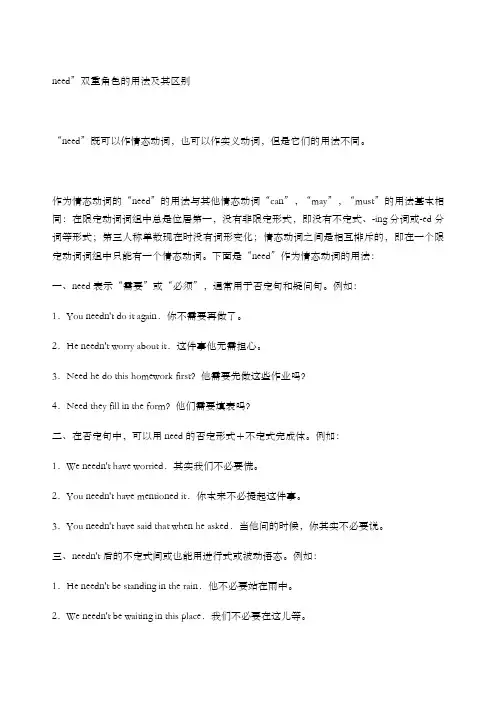
need”双重角色的用法及其区别“need”既可以作情态动词,也可以作实义动词,但是它们的用法不同。
作为情态动词的“need”的用法与其他情态动词“can”,“may”,“must”的用法基本相同:在限定动词词组中总是位居第一,没有非限定形式,即没有不定式、-ing分词或-ed分词等形式;第三人称单数现在时没有词形变化;情态动词之间是相互排斥的,即在一个限定动词词组中只能有一个情态动词。
下面是“need”作为情态动词的用法:一、need表示“需要”或“必须”,通常用于否定句和疑问句。
例如:1.You needn't do it again.你不需要再做了。
2.He needn't worry about it.这件事他无需担心。
3.Need he do this homework first?他需要先做这些作业吗?4.Need they fill in the form?他们需要填表吗?二、在否定句中,可以用need的否定形式+不定式完成体。
例如:1.We needn't have worried.其实我们不必要慌。
2.You needn't have mentioned it.你本来不必提起这件事。
3.You needn't have said that when he asked.当他问的时候,你其实不必要说。
三、needn't后的不定式间或也能用进行式或被动语态。
例如:1.He needn't be standing in the rain.他不必要站在雨中。
2.We needn't be waiting in this place.我们不必要在这儿等。
3.The hedges needn't be trimmed thisweek.本周树蓠不必要整修。
“need”作为实义动词时,通常用法是:人+need +to do物+need +doing物+need +to be done另外,“need”后还可以直接跟名词。
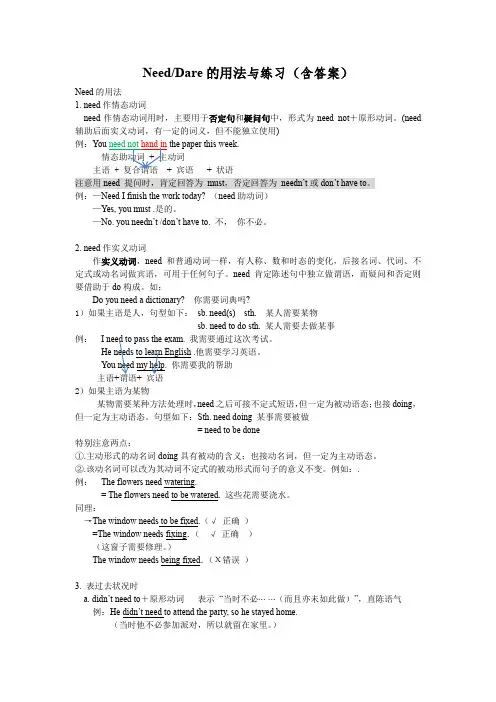
Need/Dare的用法与练习(含答案)Need的用法1. need作情态动词need作情态动词用时,主要用于否定句和疑问句中,形式为need not+原形动词。
(need 辅助后面实义动词,有一定的词义,但不能独立使用)例:宾语+ 状语注意用need 提问时,肯定回答为must,否定回答为needn’t或don’t have to。
例:—Need I finish the work today? (need助动词)—Yes, you must .是的。
—No. you needn’t /don’t have to. 不,你不必。
2. need作实义动词作实义动词,need和普通动词一样,有人称、数和时态的变化,后接名词、代词、不定式或动名词做宾语,可用于任何句子。
need肯定陈述句中独立做谓语,而疑问和否定则要借助于do构成。
如:Do you need a dictionary? 你需要词典吗?1)如果主语是人,句型如下:sb. need(s) sth. 某人需要某物sb. need to do sth. 某人需要去做某事例:I need to pass the exam. 我需要通过这次考试。
He needs to learn English .他需要学习英语。
You need my help.主语+2)如果主语为某物某物需要某种方法处理时,need之后可接不定式短语,但一定为被动语态;也接doing,但一定为主动语态。
句型如下:Sth. need doing 某事需要被做= need to be done特别注意两点:①.主动形式的动名词doing具有被动的含义;也接动名词,但一定为主动语态。
②.该动名词可以改为其动词不定式的被动形式而句子的意义不变。
例如:.例:The flowers need watering.= The flowers need to be watered. 这些花需要浇水。
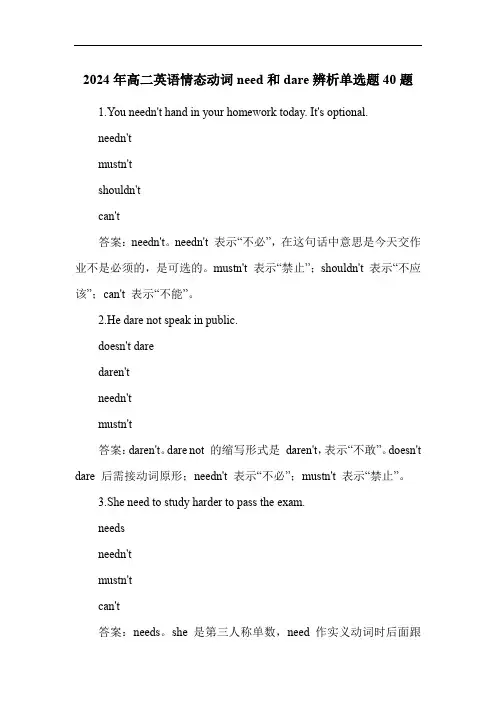
2024年高二英语情态动词need和dare辨析单选题40题1.You needn't hand in your homework today. It's optional.needn'tmustn'tshouldn'tcan't答案:needn't。
needn't 表示“不必”,在这句话中意思是今天交作业不是必须的,是可选的。
mustn't 表示“禁止”;shouldn't 表示“不应该”;can't 表示“不能”。
2.He dare not speak in public.doesn't daredaren'tneedn'tmustn't答案:daren't。
dare not 的缩写形式是daren't,表示“不敢”。
doesn't dare 后需接动词原形;needn't 表示“不必”;mustn't 表示“禁止”。
3.She need to study harder to pass the exam.needsneedn'tmustn'tcan't答案:needs。
she 是第三人称单数,need 作实义动词时后面跟动词不定式,且主语是第三人称单数时要用needs。
needn't 表示“不必”;mustn't 表示“禁止”;can't 表示“不能”。
4.We dare to challenge ourselves.don't darearen't dareneedn'tmustn't答案:dare to。
dare to do sth 表示“敢于做某事”。
don't dare 后需接动词原形;aren't dare 表述错误;needn't 表示“不必”;mustn't 表示“禁止”。
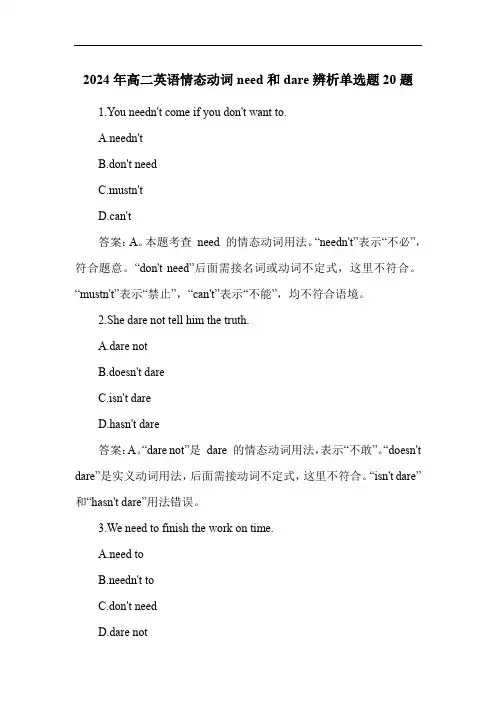
2024年高二英语情态动词need和dare辨析单选题20题1.You needn't come if you don't want to.A.needn'tB.don't needC.mustn'tD.can't答案:A。
本题考查need 的情态动词用法。
“needn't”表示“不必”,符合题意。
“don't need”后面需接名词或动词不定式,这里不符合。
“mustn't”表示“禁止”,“can't”表示“不能”,均不符合语境。
2.She dare not tell him the truth.A.dare notB.doesn't dareC.isn't dareD.hasn't dare答案:A。
“dare not”是dare 的情态动词用法,表示“不敢”。
“doesn't dare”是实义动词用法,后面需接动词不定式,这里不符合。
“isn't dare”和“hasn't dare”用法错误。
3.We need to finish the work on time.A.need toB.needn't toC.don't needD.dare not答案:A。
本题考查need 的实义动词用法。
“need to do sth”表示“需要做某事”。
“needn't to”用法错误,need 作情态动词时否定形式是needn't,后面不能加to。
“don't need”后面需接名词或动词不定式,这里缺少to finish,不符合。
“dare not”不符合语境。
4.He dare not climb that high tree.A.dare notB.doesn't dareC.isn't dareD.mustn't答案:A。
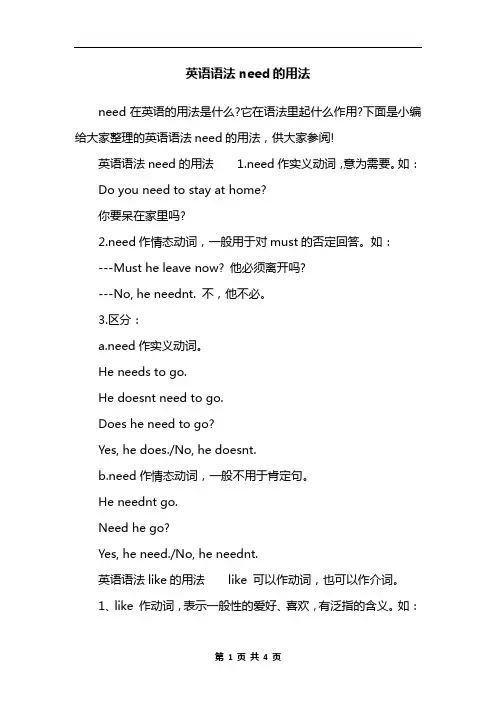
英语语法need的用法need在英语的用法是什么?它在语法里起什么作用?下面是小编给大家整理的英语语法need的用法,供大家参阅!英语语法need的用法 1.need作实义动词,意为需要。
如:Do you need to stay at home?你要呆在家里吗?2.need作情态动词,一般用于对must的否定回答。
如:---Must he leave now? 他必须离开吗?---No, he neednt. 不,他不必。
3.区分:a.need作实义动词。
He needs to go.He doesnt need to go.Does he need to go?Yes, he does./No, he doesnt.b.need作情态动词,一般不用于肯定句。
He neednt go.Need he go?Yes, he need./No, he neednt.英语语法like的用法like 可以作动词,也可以作介词。
1、like 作动词,表示一般性的爱好、喜欢,有泛指的含义。
如:Do you like the color?你喜爱这种颜色吗?like 后可接不定式(like to do sth),也可接动词的-ing分词(like doing sth),有时意思不尽相同。
如:She likes eating apples.她喜爱吃苹果。
(习惯)She likes to eat an apple.她喜爱吃一粒苹果。
(平常不喜欢吃) like 与would 连用,后接不定式,表示愿望或客气的请求。
如:Would you like a cup of tea?您愿意喝杯茶吗?喜欢某人做某事可以用结构like sb to do sth/doing sth。
如:They all like me to sing/singing English songs.他们都喜欢我唱英文歌。
2、like 作介词,可译成像......。
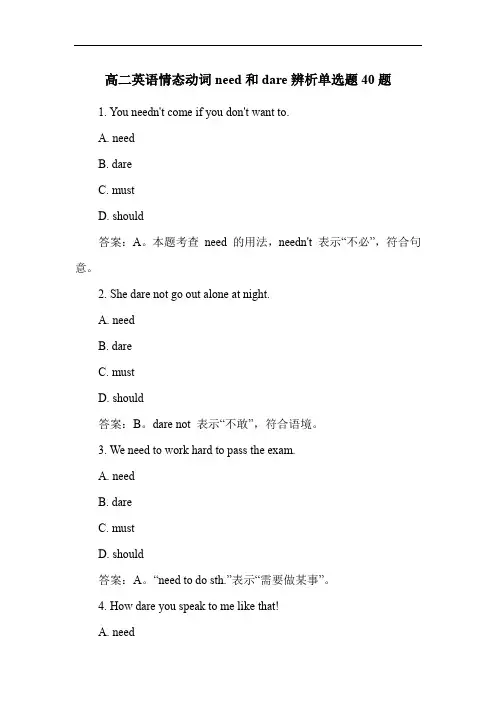
高二英语情态动词need和dare辨析单选题40题1. You needn't come if you don't want to.A. needB. dareC. mustD. should答案:A。
本题考查need 的用法,needn't 表示“不必”,符合句意。
2. She dare not go out alone at night.A. needB. dareC. mustD. should答案:B。
dare not 表示“不敢”,符合语境。
3. We need to work hard to pass the exam.A. needB. dareC. mustD. should答案:A。
“need to do sth.”表示“需要做某事”。
4. How dare you speak to me like that!A. needB. dareC. mustD. should答案:B。
“How dare you...”是常见的表达“你怎么敢...”,用dare。
5. You don't need to worry about it.A. needB. dareC. mustD. should答案:A。
don't need to 表示“不需要”。
6. I dare say he will come.A. needB. dareC. mustD. should答案:B。
“I dare say”是固定短语,表示“我想,大概”。
7. They needn't have done it.A. needB. dareC. mustD. should答案:A。
“needn't have done”表示“本不必做某事(但做了)”。
8. He dare not tell the truth.A. needB. dareC. mustD. should答案:B。
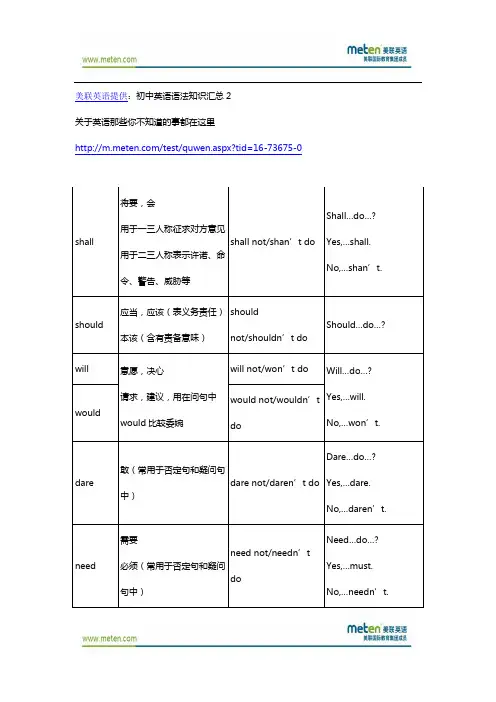
美联英语提供:初中英语语法知识汇总2关于英语那些你不知道的事都在这里/test/quwen.aspx?tid=16-73675-0II. 情态动词must, may, might, could, can表示推测:以must为例。
must + do(be)是推测现在存在的一般状态进行;must + be doing 推测可能正在进行的事情;must +have done是推测可能已经发生过的事情。
1. must“肯定,一定”语气强,只用于肯定句中。
He must be a man from America. / He must be talking with his friend. / He must have already arrived there.2. may和might“也许”,后者语气弱,更没有把握。
可用于肯定句和否定句。
He may not be at home. / They might have finished their task.3. can和could“可能”,could表示可疑的可能性,不及can’t语气强,用于肯定、否定、疑问句中。
The weather in that city could be cold now.We could have walked there; it was so near.(推测某事本来可能发生,但实际上没有发生)Can he be in the office now? No, he can’t be there, for I saw him in the library justnow.(语气很强,常用于疑问句和否定句中)III. 情态动词注意点:1. can和be able to: 都可以表示能力。
但be able to可以表达“某事终于成功”,而can 无法表达此意。
Be able to有更多的时态。
另外,两者不能重叠使用。
2. used to和would:used to表示过去常常做现在已经不再有的习惯,而would只表示过去的习惯或喜好,不涉及现在。
英语语法情态动词情态动词情态动词是高考的重点考查项目,对学习情态动词的要求是:首先、了解情态动词各自的基本意义及用法,然后掌握情态动词表示推测的用法(其中重点是对表过去推测的用法)还要注意带有情态动词的反意疑问句的用法。
情态动词的特征:1.本身有词义,但完全。
因此不能独立作谓语,只能和动词原形一起构成谓语。
2.后接动词不定式一律不带to3.不随人称和数的变化。
情态动词各自的基本意义及用法表一、can 与could用法对比表对比点can could1、表“能力” Can you lift this heavy box? I couldn‟t understand what he said at all.2、表“许可” Y ou can use a different material instead. He said I could borrow his bike.3、“怀疑” No, no, it can‟t be true.What on earth can this mean? We thought the story could not be true. How could you be so careless?4、can与be able to 区别1. could代替can,表示语气更为婉转。
Eg. Could I use your bike? Y es, I can2. can (能够)=be able to(仅表能力时),但be able to 表示一番努力后,才能做得到,且有更多的时态。
He was a good swimmer, so he __________ swim to the river bank when the boat sank.A. couldB. mightC. shallD. was able to表二、may与might用法对比表对比点may Might1.表“询问” May I …?(=Can I …?) Might I …?(=Could I…?)(但比用may 更客气)2.表“允许” Y ou may take the boy there. He told me he might come .(might与told相呼应) 3.表“可能”“或许” She may nor like this place. I‟m afraid he might not like this play.注: 1. May I…?的答语。
高二英语情态动词need和dare辨析单选题40题1. You ______ worry about the exam. You have prepared well.A. needn'tB. dare notC. mustn'tD. couldn't答案:A。
本题考查need 的用法。
needn't 表示“不必”,符合语境,即你不必担心考试,因为你准备得很好。
dare not 表示“不敢”,mustn't 表示“禁止”,couldn't 表示“不能”,都不符合语境。
2. He ______ go out at night because he is afraid of the dark.A. needn'tB. dare notC. doesn't need toD. didn't dare答案:B。
本题考查dare 的用法。
dare not 表示“不敢”,符合“他因为怕黑晚上不敢出去”的语境。
needn't 表示“不必”,doesn't need to 表示“不需要”,didn't dare 形式错误。
3. We ______ finish the work today. It's not very urgent.A. needn'tB. dare notC. mustn'tD. shouldn't答案:A。
这里needn't 表示“不必”,意思是我们今天不必完成这项工作,它不是很紧急。
dare not 是“不敢”,mustn't 是“禁止”,shouldn't 是“不应该”,都不符合题意。
4. She ______ speak English in public, but she does it very well now.A. dare notB. needn'tC. didn't dare toD. doesn't need to答案:C。
Need的用法1. need 是英语中两个比较特殊的动词之一(另一个是dare),既是及物动词又是情态动词。
作情态动词用多见于英国英语中,而且仅用在否定句和疑问句中。
如:2. need 作情态助动词通常不用在肯定句中(*He need go now.), 但在表示怀疑或否定概念的主句之后的宾语分句里或主语分句里,可以用情态助动词的肯定形式。
如:I don’t think you/ he need go just yet.I wonder if we need take sleeping-bags.The only thing you need to do is (to) fill in this form.(=You don’t need to do anything else。
)All you need do is to take a taxi from the airport.情态动词need的肯定式主要用在正式文体中。
在非正式文体中,need 作及物动词用也许更普遍。
如:I wonder if we need to take sleeping-bags.I don’t think he needs to go just yet.The only thing you need to do is (to) fill in this form.3. need 没有过去、现在的时态区别。
如果要表示过去时间可用“need have + -ed分词”的结构。
如:Need you have told him about my plans?You needn’t have told him about my plan.据CGoEL, You need not have done it. 几乎等于You did not need to do it. 但是,need have+-ed 分词结构隐含有与事实相反的意思,need to 的结构则没有。